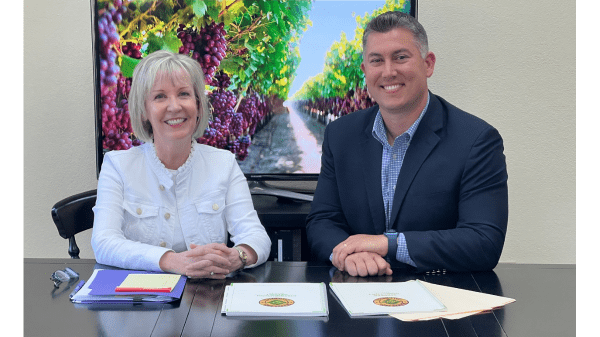I contacted Ian LeMay, currently president of the California Fresh Fruit Association (CFFA), to congratulate him on his new appointment as incoming president of the California Table Grape Association (CTGA).
LeMay will succeed current CTGA president Kathleen Nave, although the transition process will take place gradually over the next year so that CFFA can search for and hire a new president.

We had some time to discuss the present situation. With regard to the 13 fresh fruit crops represented by CFFA, LeMay expressed optimism for the year. Growers were “fortunate not to see as many direct impacts as many others in the state have seen,” he says.
“I’m hopeful about the upcoming season,” LeMay added. “Heavy rains gave our root zones a great heavy soaking. We’re now starting to ease into warmer, drier days.”
Most of the orchard crops represented by CFFA are on the east side of the San Joaquin Valley, where flooding has not been as problematic as elsewhere in the state. “We have some earlier season stone fruit in the western part of the Valley, but that growing region won’t be impacted by the flooding,” said LeMay.
“Consumers should be excited” about the quality of this season’s crops, LeMay says. “I feel that with the winter and spring we’ve had, there’s a lot of promise for California fresh fruit.”
We also discussed the state’s water situation in the wake of this season’s heavy snows and rains, which put an end to California’s extreme drought—sort of.
No doubt like most California agricultural leaders, LeMay believes that the drought problem won’t truly be over until the state moves ahead with major infrastructure projects to increase storage capacity.
“We haven’t even kept up on the full maintenance of existing projects to keep up with existing demands,” LeMay says.
“There is currently discussion in Sacramento about a potential bond for water infrastructure,” he continued. “We’re beginning to engage in those conversations, but many voters have become highly skeptical about the true intent of a water bond”—that is, whether the state is actually going to use the money for the purpose approved.
Bonds of this kind must be approved by a referendum of California voters.
Voters approved Proposition 1 in 2014, authorizing $7.45 billion “to fund ecosystems and watershed protection and restoration, water supply infrastructure projects, including surface and groundwater storage, and drinking water protection.”
but after nearly a decade, the state has made little progress in achieving these goals, LeMay noted, which “has diminished voter confidence. There is doubt that the voters’ intent with that bond is actually being executed by the state.”
LeMay cited voter skepticism about this progress as a reason for the defeat of another water bond, Proposition 3, in 2018.
California orchard growers have exerted themselves to manage their water supplies, LeMay added, noting that most acreage is now employing drip or similar irrigation methods.
“Some older acreage isn’t, but once an orchard or vineyard goes out, irrigation practices like drip are being implemented” for replacements.
“These are not inexpensive propositions,” LeMay says. “Being purposeful in our growing practices is top of mind every day.”



